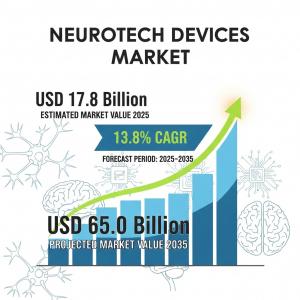Neurotech Devices Market to Soar from USD 17.8B in 2025 to USD 65.0B by 2035, at 13.8% CAGR
Neurotech Devices Market to Grow at 13.8% CAGR, Offering Manufacturers a Solution-Focused Pathway to Capture a USD 65 Billion Opportunity.
NEW YORK, DE, UNITED STATES, August 8, 2025 /EINPresswire.com/ -- The neurotech devices market is experiencing a profound transformation, moving beyond niche applications and into the mainstream of modern medicine. This dynamic market, valued at an estimated USD 17.8 billion in 2025, is on a trajectory to reach an impressive USD 65 billion by 2035, driven by a robust 13.8% compound annual growth rate (CAGR). This rapid expansion presents a significant opportunity for manufacturers, particularly those seeking to address key challenges and capitalize on future growth. The convergence of neuroscience, miniaturized medical electronics, and a rising demand for innovative therapies is creating a fertile ground for market leaders and emerging innovators alike.
Addressing Core Challenges with Data-Driven Solutions
For manufacturers, the neurotech market's growth is a direct response to some of the most pressing challenges in healthcare. The increasing prevalence of neurological disorders, coupled with a heightened focus on brain health, is driving demand for advanced, non-invasive, and effective interventions. Hospitals and specialty centers are actively integrating these devices to improve patient outcomes while simultaneously reducing long-term care costs—a critical factor for healthcare systems globally. This focus on efficiency and improved patient quality of life is a clear signal to manufacturers about where to direct their innovation and investment.
A key takeaway for manufacturers is the market's leading segment: pain management. Projected to command 22.8% of the total market revenue in 2025, this segment is a powerhouse of growth. The widespread clinical preference for neurostimulation and neuromodulation techniques to manage chronic pain—where traditional therapies often fail—is the primary driver. For manufacturers, this highlights the immense potential in developing solutions that reduce opioid dependency and enhance the quality of life for millions of patients. The adoption of more precise, patient-controlled, and minimally invasive devices in this space reinforces the need for solutions that are not only effective but also user-friendly and clinically validated.
The Hospital Channel: A Gateway to Market Leadership
The hospital end-use segment is the primary channel for market penetration, projected to hold a substantial 47.3% of the market revenue in 2025. This dominance is no accident; it is built on the foundation of established infrastructure, clinical expertise, and the ability to seamlessly integrate advanced neurotech devices into standard treatment protocols. For manufacturers, understanding this dynamic is crucial. Hospitals represent a centralized purchasing capacity, offering access to multidisciplinary teams and a trusted environment for device deployment and management. The trust associated with hospital-administered therapies and their ability to scale programs cements their role as the most important channel for neurotech device utilization. Manufacturers who can effectively partner with hospitals and provide comprehensive support—from training to implementation—will be well-positioned for long-term success.
Request Neurotech Devices Market Draft Report: https://www.futuremarketinsights.com/reports/sample/rep-gb-22617
For more on their methodology and market coverage, visit https://www.futuremarketinsights.com/about-us
Global Opportunities and Strategic Growth Hotspots
The neurotech market’s growth is a global phenomenon, with specific regions showing exceptional promise. China, for example, is leading the charge with a remarkable 18.6% CAGR through 2035, fueled by aggressive government funding and a rapidly expanding medtech ecosystem. India follows closely at 17.3%, driven by rising incidences of neurological disorders and a strategic push toward digital health integration. In Europe, Germany is advancing at 15.9%, supported by strong clinical research networks and an aging demographic. For manufacturers, these regional insights are not just statistics; they are a roadmap for strategic expansion and market entry. The report provides detailed insights across over 40 countries, with these five highlighted for their strategic influence and growth trajectory. Manufacturers can leverage this data to identify new markets, tailor their products to regional needs, and secure their place in the global neurotech landscape.
Editor’s Note
The neurotech devices market is positioned for exceptional growth as innovation meets rising demand. This press release is intended to provide a unique, data-driven perspective for manufacturers seeking strategic opportunities in this transformative industry.
Discover Related Research:-
Arthroscopy Visualization Systems Market
https://www.futuremarketinsights.com/reports/arthroscopy-visualization-systems-market
Capnography Equipment Market
https://www.futuremarketinsights.com/reports/capnography-equipment-market
Transcutaneous Monitors Market
https://www.futuremarketinsights.com/reports/transcutaneous-monitors-market
Rahul Singh
Future Market Insights Inc.
+1 347-918-3531
email us here
Legal Disclaimer:
EIN Presswire provides this news content "as is" without warranty of any kind. We do not accept any responsibility or liability for the accuracy, content, images, videos, licenses, completeness, legality, or reliability of the information contained in this article. If you have any complaints or copyright issues related to this article, kindly contact the author above.
Mobility Aid Medical Device Industry Analysis Report 2025: Key Trends, Drivers, and Forecast Insights
Lancet Market Set to Reach $4.25 Billion by 2029
Medicated Skincare Market - Opportunities, Share, Growth and Competitive Analysis and Forecast 2029
Więcej ważnych informacji
 Jedynka Newserii
Jedynka Newserii

 Jedynka Newserii
Jedynka Newserii

Finanse

K. Gawkowski: Polska w cyfrowej transformacji gospodarki awansowała do pierwszej ligi w Europie. 2,8 mld zł z KPO jeszcze ten proces przyspieszy
Uruchomiony na początku lipca przez Ministerstwo Cyfryzacji i BGK program „KPO: Pożyczka na cyfryzację” cieszy się dużym zainteresowaniem. Samorządy, uczelnie oraz firmy mogą wnioskować o wsparcie finansowe dla inwestycji w transformację cyfrową, m.in. modernizację infrastruktury czy cyberbezpieczeństwo. W sumie na ten cel trafi 2,8 mld zł (650 mln euro). Ze względu na krótki czas naboru obie instytucje organizują w poszczególnych województwach warsztaty dla wnioskodawców, które mają rozwiać ich wątpliwości przy przygotowywaniu wniosków.
Prawo
Koszty certyfikacji wyrobów medycznych sięgają milionów euro. Pacjenci mogą stracić dostęp do wyrobów ratujących życie

Od 2027 roku wszystkie firmy produkujące wyroby medyczne w Unii Europejskiej będą musiały posiadać certyfikat zgodności z rozporządzeniem MDR (Medical Devices Regulation). Nowe przepisy wprowadzają dużo ostrzejsze wymagania w zakresie dokumentacji, badań klinicznych oraz procedur certyfikacyjnych. Branża ostrzega, że część małych i średnich producentów nie zdąży się dostosować. Problemem jest także wysoki koszt i długi czas uzyskiwania certyfikatów. W konsekwencji z rynku mogą zniknąć urządzenia ratujące życie.
Infrastruktura
Nowe przepisy o ochronie ludności cywilnej wprowadzają obowiązkowe elastyczne zbiorniki na wodę. Mają one służyć w razie suszy, pożarów czy wybuchu wojny

Samorządy będą musiały posiadać m.in. elastyczne zbiorniki na wodę pitną i przenośne magazyny wody przeciwpożarowej. To element odpowiedniego przygotowania zasobów na wypadek sytuacji kryzysowych, kataklizmów czy wybuchu konfliktu, wprowadzony nowymi przepisami o ochronie ludności. Eksperci podkreślają, że tego typu rozwiązania to innowacyjne produkty, które nie tylko ułatwiają logistykę w sytuacjach kryzysowych, ale także mogą znacząco skrócić czas reakcji służb ratunkowych.
Partner serwisu
Szkolenia

Akademia Newserii
Akademia Newserii to projekt, w ramach którego najlepsi polscy dziennikarze biznesowi, giełdowi oraz lifestylowi, a także szkoleniowcy z wieloletnim doświadczeniem dzielą się swoją wiedzą nt. pracy z mediami.








.gif)

 |
| |
| |
|